The Chase Freedom Unlimited review: stands out in a crowded field of cashback credit cards by offering something many competitors don’t: simplicity without sacrifice. While other cards require you to track rotating categories or cap your earnings, this card delivers consistent 1.5% cash back on every purchase with no annual fee.
But here’s what makes it particularly interesting—those “cash back” rewards are actually Chase Ultimate Rewards points in disguise. This opens up possibilities that most flat-rate cashback cards simply can’t match, especially if you’re already part of the Chase ecosystem or considering building one.
The question isn’t just whether you’ll earn decent rewards (you will), but whether this card fits your spending habits and long-term credit strategy. Let’s break down exactly what you get, what you don’t, and who benefits most from adding this card to their wallet.
Chase Freedom Unlimited Review: What You Get With?
Earning Structure That Actually Makes Sense
The Chase Freedom Unlimited keeps things refreshingly simple with its earning categories:
- 5% on travel purchased through Chase Travel℠
- 3% on dining at restaurants, including takeout and delivery
- 3% on drugstore purchases
- 1.5% on everything else
Unlike cards with rotating 5% categories that require quarterly activation, these rates stay consistent year-round. You’ll never miss out on bonus earnings because you forgot to enroll or because you hit a spending cap.
The 3% dining rate particularly shines for everyday spending. Whether you’re grabbing coffee, ordering takeout, or dining out for special occasions, this category covers a significant portion of many people’s discretionary spending.
The Ultimate Rewards Advantage
Here’s where the Chase Freedom Unlimited gets interesting. Despite being marketed as a cash back card, you’re actually earning Chase Ultimate Rewards points at a 1:1 ratio.
These points can be redeemed as cash back at 1 cent per point, but they become significantly more valuable when combined with other Chase cards.
If you have a Chase Sapphire Preferred® Card or Chase Sapphire Reserve®, you can transfer your Freedom Unlimited points to their accounts and redeem them for travel at enhanced rates—1.25 cents per point with the Preferred or 1.5 cents per point with the Reserve. You can also transfer points to airline and hotel partners for potentially even higher value.
This flexibility transforms a simple cashback card into a cornerstone of a comprehensive rewards strategy.
Welcome Bonus and Ongoing Benefits
New cardholders can earn a $200 bonus after spending $500 in the first three months—a relatively low spending requirement that most people can meet naturally.
The card also includes standard Chase benefits like purchase protection and extended warranty coverage.
Notable features include:
- Zero liability protection on unauthorized purchases
- Account alerts to help monitor spending
- FICO® Score tracking through Chase Credit Journey
- No foreign transaction fees (wait—actually, there’s a 3% foreign transaction fee, so this isn’t ideal for international spending)
Where This Card Falls Short
Limited Premium Perks
The Chase Freedom Unlimited focuses on earning rewards rather than providing luxury benefits. You won’t find airport lounge access, statement credits, or premium customer service lines. The card includes basic protections, but nothing that rivals premium travel cards.
Foreign Transaction Fees
The 3% foreign transaction fee makes this card less appealing for international spending. If you travel abroad frequently, you’ll want to pair this with a no-foreign-fee card or use it primarily for domestic purchases.
Modest Welcome Bonus
While the $200 welcome bonus is achievable, it’s not particularly generous compared to some competitors offering $300+ bonuses or higher earning rates in the first year.
How It Stacks Up Against Competitors
Versus Other Flat-Rate Cards
The Citi Double Cash® Card earns 2% back on everything (1% when you buy, 1% when you pay), making it a stronger choice for pure cash back earning. However, it lacks the Chase ecosystem benefits and bonus categories.
The Capital One Venture Rewards Credit Card offers 2x miles on everything with more premium benefits, but comes with a $95 annual fee that the Chase Freedom Unlimited avoids.
Within the Chase Family
The Chase Freedom Flex℠ offers 5% on rotating quarterly categories (up to $1,500 in spending, then 1%) plus 3% on dining and drugstores year-round.
If you’re disciplined about maximizing quarterly categories, the Flex might deliver higher overall earnings.
However, the Freedom Unlimited works better for:
- People who want consistency without tracking categories
- High spenders who would exceed quarterly caps
- Anyone building toward Chase’s premium travel cards
Maximizing Your Chase Freedom Unlimited
As a Standalone Card
If you’re using this card independently, focus on:
- Using it for all non-category spending where you don’t have a better option
- Taking advantage of the 3% dining and drugstore rates
- Redeeming points as cash back when you need the flexibility
As Part of the Chase Trifecta
The real power emerges when you combine the Freedom Unlimited with other Chase cards:
- Foundation: Chase Freedom Unlimited (1.5x on everything, 3x dining/drugstores)
- Quarterly Categories: Chase Freedom Flex (5x rotating categories)
- Premium Redemption: Chase Sapphire Preferred or Reserve (transfer partners and enhanced travel redemption)
This combination covers most spending categories at competitive rates while maintaining flexibility for both cash back and travel redemptions.
Who Benefits Most From This Card
Ideal Candidates
- Students and Credit Builders: The no annual fee and solid earning rate make this an excellent starter card. Chase tends to have reasonable approval requirements, and the card helps establish a relationship with a major issuer.
- High Non-Category Spenders: If you have significant expenses that don’t fit into specific bonus categories—like business supplies, utilities, or advertising—the 1.5% rate across all spending adds up quickly.
- Chase Ecosystem Builders: Anyone planning to eventually get a Chase Sapphire card should consider starting here. You’ll earn points immediately while building your credit history and relationship with Chase.
- Simplicity Seekers: If you want competitive rewards without complexity, this card delivers. No categories to track, no caps to monitor, no annual fees to justify.
Who Should Look Elsewhere
- International Spenders: The 3% foreign transaction fee makes other options more attractive for frequent travelers.
- Category Maximizers: If you’re willing to track rotating categories and maximize quarterly bonuses, the Chase Freedom Flex or other category cards might deliver higher returns.
- Premium Benefit Seekers: This card won’t provide lounge access, travel credits, or luxury perks that come with premium cards.
The Bottom Line on Chase Freedom Unlimited!
The Chase Freedom Unlimited succeeds by keeping things simple while maintaining strategic flexibility. You get consistent, competitive rewards without annual fees or category complexity.
The hidden Ultimate Rewards earning potential makes it particularly valuable for anyone interested in travel rewards down the road.
The card works exceptionally well as either a standalone option for straightforward cash back or as a foundational piece in a broader Chase rewards strategy.
While it won’t maximize earnings in every category, it provides solid returns across all your spending with minimal effort required.
Consider this card if you value simplicity, want to build relationships within the Chase ecosystem, or need a reliable catch-all card for expenses that don’t fit neatly into bonus categories.
The combination of no annual fee, decent earning rates, and strategic flexibility makes it a smart addition to most wallets!

